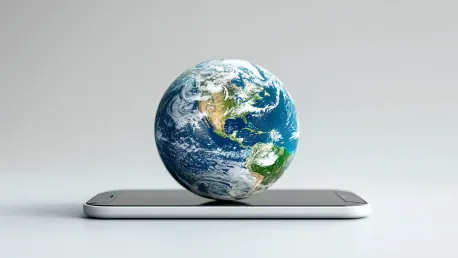The global telecommunications landscape has been significantly transformed as 5G technology continues to gain momentum. With 2.1 billion 5G subscriptions worldwide by the end of the third quarter of 2023, the technology’s reach has expanded rapidly. This figure is not only an impressive milestone but also a forecast of even greater growth, with projections suggesting that the number of 5G subscriptions will nearly hit 2.3 billion by year-end. As Ericsson reports, 5G is poised to surpass 4G as the dominant mobile technology by 2027. Markets such as China and India are driving this rapid adoption, emphasizing the global shift towards faster and more efficient communication networks.
Regional Leaders in 5G Penetration
North America’s Forefront Position
By the end of 2024, North America is expected to lead the world in 5G penetration, with an estimated 71% of mobile subscriptions. This dominance reflects a robust investment in network infrastructure and a consumer base eager for the latest technology. In North America, network investments have stabilized, yet they continue to support the growth of 5G. Increased 5G adoption, projected to reach 436 million subscriptions by 2030, will account for 91% of mobile subscriptions in the region. This ongoing expansion is fueled by mid-band 5G network coverage, which bolsters growth for Fixed Wireless Access (FWA) and facilitates broader advancements within the tech ecosystem.
The substantial investment in North America’s 5G infrastructure is evident not only in the sheer number of subscriptions but also in the sophisticated deployment of mid-band 5G technology. This technology is crucial for delivering high-speed internet coverage, especially in rural and underserved areas. Fixed Wireless Access (FWA) solutions have gained traction, addressing connectivity issues in these regions and expanding the digital landscape. Additionally, businesses across North America are increasingly utilizing 5G to innovate and streamline operations, further pushing the technology’s growth and integration into everyday life.
Gulf Cooperation Council’s Ambitious Goals
The Gulf Cooperation Council (GCC) countries are setting ambitious targets for 2030, aiming to achieve a 5G penetration rate of 93%. This remarkable target underscores the commitment of GCC countries to become leaders in advanced telecommunications. Investments in cutting-edge network infrastructure and strategic partnerships with global technology firms are key drivers behind this goal. By the end of 2024, the GCC countries are anticipated to have a 5G penetration of 47%, showing a clear trajectory towards the 2030 milestone. This rapid adoption is driven by the need to support smart city initiatives, enhance digital economies, and enable advanced applications across various sectors.
The strategic focus on 5G within the GCC is multifaceted, aimed at fostering innovation, economic growth, and technological leadership. The region’s substantial investment in building comprehensive 5G networks is complemented by initiatives to integrate this technology into various sectors, including healthcare, transportation, and manufacturing. The ability to support real-time applications, enhance data management, and improve service delivery is particularly significant for the development of smart cities. By leveraging 5G technology, GCC countries are not only transforming their telecommunications landscape but also laying the groundwork for a digitally connected and economically robust future.
The Shift Away from Legacy Technologies
Decline in 4G, 3G, and 2G Subscriptions
The global phase-out of older mobile technologies is another notable trend outlined in Ericsson’s report. During the third quarter of 2024, 4G subscriptions declined by 69 million, while 3G and 2G subscriptions dropped by 31 million and 34 million, respectively. This decrease is a clear indicator of the growing preference for 5G technology. Users worldwide are migrating to 5G networks to benefit from faster speeds, lower latency, and increased network capacity. As the rollout and adoption of 5G continue, older technologies are being phased out, paving the way for a more advanced and interconnected mobile ecosystem.
The decline in older mobile technologies is not solely driven by consumer preferences but also by strategic decisions from service providers. Globally, around 320 service providers have launched commercial 5G services, with over 60 having deployed or launched standalone (SA) 5G networks. These advanced 5G SA networks offer improved performance, reliability, and efficiency, encouraging users to transition from legacy networks. The retirement of older technologies allows for the reallocation of spectrum and resources to enhance 5G infrastructure, further accelerating its adoption and driving technological progress.
Rising Share of Mobile Data Traffic
The shift towards 5G is also reflected in mobile data traffic projections. Ericsson’s report predicts that by the end of 2024, 5G’s share of mobile data traffic will rise to 34%, and by 2030, it will dominate with an 80% share. This significant increase highlights the growing reliance on 5G networks for data-intensive applications and services. Enhanced video streaming, virtual reality experiences, and Internet of Things (IoT) deployments are among the many factors contributing to the surge in mobile data usage. As more devices become interconnected and data consumption rises, the demand for robust and high-capacity networks will continue to fuel the expansion of 5G.
The anticipated growth in 5G’s share of mobile data traffic is indicative of the transformative potential of this technology. As 5G networks expand, they are expected to accommodate a vast array of new applications and services. From autonomous vehicles to smart homes, the capabilities of 5G extend beyond mere speed improvements. The technology’s low latency and high reliability are essential for critical applications, where real-time data processing and communication are paramount. As the world becomes increasingly connected, the role of 5G in enabling advanced digital services and driving innovation across industries cannot be overstated.
Future Prospects and Strategic Implications
The Dominance of 5G by 2027
Ericsson forecasts that 5G will surpass 4G and become the dominant mobile technology by 2027. This prediction underscores the rapid pace at which 5G is being adopted globally. Several factors contribute to this swift uptake, including the growing demand for high-speed internet, the expansion of digital services, and the strategic investments in 5G infrastructure by countries and telecom operators. By harnessing the capabilities of 5G, businesses and consumers alike can leverage faster connectivity, enhanced communication, and innovative applications that were previously unattainable with older technologies.
The impending dominance of 5G highlights the strategic importance of continued investment in this technology. Governments and enterprises worldwide are recognizing the potential of 5G to drive economic growth, foster innovation, and improve quality of life. As more regions achieve widespread 5G coverage, the benefits of this technology will become increasingly apparent. Enhanced mobile experiences, improved access to digital services, and the acceleration of digital transformation across industries are among the many advantages that 5G promises to deliver.
Strategic Implications for Telecom Operators
The global telecommunications landscape is undergoing a significant transformation as 5G technology continues to gain traction. By the end of the third quarter of 2023, the number of global 5G subscriptions had surged to 2.1 billion, showcasing the rapid expansion of this next-generation technology. This remarkable milestone is just the beginning, as projections indicate that 5G subscriptions are expected to reach nearly 2.3 billion by the end of the year.
According to Ericsson, 5G is on track to surpass 4G as the leading mobile technology by 2027. This shift is mainly driven by key markets such as China and India, where the adoption of 5G is advancing at an impressive pace. These countries are playing a crucial role in the global transition towards faster and more efficient communication networks. As 5G continues to grow, its impact on various industries and everyday life will likely be profound, ushering in a new era of connectivity. This trend signifies not only a technological leap but a global shift towards more efficient and high-speed communication.









